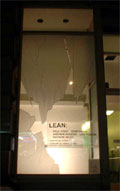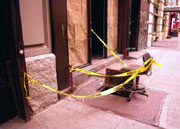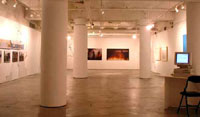 |
|
 |
| ◆LEAN |
 |
 Exhibition
featuring works by Exhibition
featuring works by
Paul Chan, Isami
Ching, Andrew Rogers, Lan Tuazon, and
Kehinde Wiley
Curator:
Eungie Joo
Opening Reception:
Saturday, February
22, 2003, 6-8pm
Exhibition Dates:
February 22 to March
29, 2003 |
|
| Event: |
| Artist Talk March
15, 2003, 3pm |
|
| The Ise Cultural
Foundation presents LEAN: Paul Chan, Isami Ching,
Andrew Rogers, Lan Tuazon, and Kehinde Wiley: |
| An exhibition that
strives to explore an aesthetic cooperation between
works, prioritizing the relationship between the visual
and conceptual logic within. Works include figurative
painting, photography, sculpture, new media and film. |
Lean is a curatorial effort to explore the
concept of aesthetic cooperation between works, one
that prioritizes visuality and how visuality might
relate to and expand our grasp of the conceptual logic
practiced within a work. Paul Chan, Isami Ching,
Andrew Rogers, Lan Tuazon, and Kehinde Wiley approach
the formal conventions of their respective media with
an analytical curiosity that destabilizes the reliability
of codified forms. While theirs are not simply deconstructionist
agendas, the artists' engagements with structural
convention question the efficacy of our visual language
urging us to reconsider societal systems and our relationship
to the natural world. Lean addresses formal aesthetic
conventions in contemporary art practice as a vehicle
of communication, drawing upon practitioners of abstract
and figurative painting (Wiley), landscape photography
(Rogers), sculpture and performance (Ching, Tuazon),
and new media/film (Chan).
 |
Paul Chan explores utopic desire, forms of
communication, and exchange in his work. Chan creates
animated characters, computer fonts, and substitute
narratives that are in and of themselves systems of
knowledge. For this exhibition, he will show prints
from Alternumerics (2001). In this project, Chan developed
several different fonts for word processing that translate
everyday text into linguistic and gestural drawings.
In Map of the Future I-IV (2002), Chan has applied
his most complicated font, The Future Must Be Sweet,
After Fourier. This font was developed by combining
the major tenets of the utopian philosophy of Charles
Fourier (in order of their significance) with statistical
information on letter usage and the frequency of letter
combinations in the English language. To this Chan
added the element of drawing in three-dimensions:
straight lines that "connect" ideas into
a continuous system, thus creating a kind of narrativity
within the structure of a word or idea.
Isami Ching is interested in concepts of ambiguity,
masquerade, humor, and the accidental. His work addresses
notions of order, the confluence of forces behind
a sculptural gesture, and the relationship between
the viewer and the charged space around a sculptural
object. In Correspondence (2001), which will be presented
as part of Lean, mechanized scissors sit atop a ceiling
beam. We hear the sound of the scissors' snips at
40-second intervals, as thin strips of paper tumble
in the air, wafting to the gallery floor like seedpods.
The strips contain fragments of text, an incomplete
"Dear Jane" letter reconsidered as tens
of thousands of temporal gestures descending gracefully
across time, space and intent: object becomes function,
text becomes object, repetition becomes form. While
his investigations accept the viewer's employment
of prejudice, assumption, and simplification as a
kind of defensive system of order in the face of infinite
possibilities, Ching's work continues to strive for
a purer, more immediate state of interaction.
Combining the detached, objective language of documentary
photography with a rich, painterly palette, Andrew
Rogers' luscious chromogenic prints explore the built
environment as natural landscape. In Landscape, Geological
and Other Features (2002), Rogers employs a low perspective
"to give the sense to the viewer that they do
have access, that there is no such thing as private
property, borders and barriers...The site existed
to me as a kind of metaphor for another world, much
in the same way the western landscapes functioned
for the early photographic explorers. And it exists
in reality as another world, no longer what it has
been and not yet what it will be. Not only a place
in transition, but also a new creation in and of itself."
Focusing on spaces in transition, Rogers strives for
a relationship between the viewer and image that is
concrete and physicalムa relationship to the landscapes
pictured; a relationship to an uncontainable present.
The concept of aesthetic cooperation at the core of
Lean necessarily relies upon a dynamic interaction
between works. Central to the project is the work
of Lan Tuazon. Tuazon's work in photography and sculpture
has explored the narrative and ethnographic in search
of a new form of exchange between subject and artist,
between representation and object. She has also come
to think about public space and the sometimes contentious
social agreement of the appropriate behavior for those
spaces. Tuazon's drawings on acetate suggest the artifice
of architectural and social order and its power to
erase reality. Depicting crumbling walls and shot
out glass in a cartoonish style, and applied directly
to the surface of walls and windows, these images
reject the complacency of our flat world. Tuazon's
works will be made in dialogue with the exhibition
floorplan, interacting with the physical location
of other works in the gallery.
 |
Kehinde Wiley's works admit an early interest
in Neoclassical and Romantic painting as escape, spectacle,
and representations of beauty. But his are also about
absolute or free play ? la Peter Halley and Mel Bochner.
Relying on pastels and ornament, Wiley explores the
dissonance between object and original, past and present,
and fore- and background, offering a self-consciously
delicious brand of portraiture that is smart, witty,
and scathing. Combining the flamboyant motifs of French
rococo, classical figuration, and a lively engagement
with color to address representations of masculinity
and beauty, he admits, "I see now how I critique
and embrace the same traditions, like sibling histories.
I like to think of history as a rhetorical device.#
As they lure the viewer into a complex web of aesthetics
and social critique, Wiley's elegant, elaborate works
question the very plausibility of figurative painting
as a gesture and the relevance of beauty and aesthetics
as systems of comprehension.
Eungie Joo is a curator and writer based in New
York. She has curated Widely Unknown at Deitch Projects
(2001) and the 2002 MFA Thesis Exhibition at Columbia
University. This spring she is co-curator of Time
After Time: Asia and our Moment with Doryun Chong
and Rene De Guzman, which opens April 2003 at Yerba
Buena Center for the Arts, San Francisco.
Venue: Ise Gallery, 555 Broadway,
New York, NY 10012
Gallery Hours: Tuesday through Saturday, 12
noon-6pm
Admission Policy: Unless otherwise noted, all
events are free and open to the public
Contact: David Squeri at (212) 925-1649 squeri@isefoundation.org
The Ise Cultural Foundation: Established in
1983, the foundation is a non-profit organization
with the goal of promoting projects dealing with current
issues in art and culture. Gallery actives include
financial and material support for exhibitions reflecting
a wide scope of themes within the framework of contemporary
art. |
|
| |
|
|



